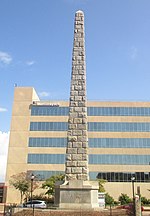Asheville Art Museum

The Asheville Art Museum is a nonprofit visual art organization in Western North Carolina (WNC) and is accredited by the American Alliance of Museums. The museum is located on the center square of downtown Asheville, 2 South Pack Square at Pack Place.The Asheville Art Museum presents exhibitions and public programs based on its permanent collection of 20th and 21st century American art. The museum features regional and national artists through special exhibitions, and showcases works of significance to Western North Carolina's cultural heritage including Studio Craft, Black Mountain College and Cherokee artists. Educational programs for children and adults are also offered.
Excerpt from the Wikipedia article Asheville Art Museum (License: CC BY-SA 3.0, Authors, Images).Asheville Art Museum
South Pack Square, Asheville
Geographical coordinates (GPS) Address Website External links Nearby Places Show on map
Geographical coordinates (GPS)
| Latitude | Longitude |
|---|---|
| N 35.5944 ° | E -82.551 ° |
Address
Asheville Art Museum
South Pack Square 2
28801 Asheville
North Carolina, United States
Open on Google Maps









